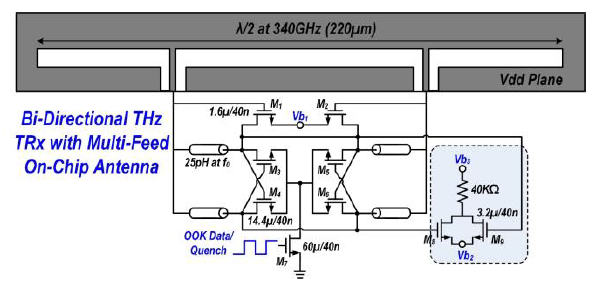Hua Wang, Taiyun Chi, and Min-Yu Huang from the school of Electrical and Computer Engineering at Georgia Tech created an invention that uses complementary metal oxide semiconductor and silicon-germanium heterojunction bipolar transistor processes to develop nano-scaled radios operating at sub-mm-Wave and THz frequencies. The bidirectional circuit-sharing THz radio can be configured either as a harmonic-oscillator based THz transmitter or a super-harmonic regenerative THz receiver. The design ensures both ultra-compact form-factor and ultra-low power operation of the THz radio. An on-chip multi-feed antenna structure achieves direct on-chip power combining/splitting and radiation for the THz transmitting/receiving signals without signal loss. The antenna eliminates the need for any additional packaging to further reduce size and minimize complexity. The overall architecture substantially improves receiver sensitivity and drastically reduces the receiver power consumption.
- A THz fully integrated super-harmonic (2nd harmonic) regenerative receiver architecture, which detects the incoming THz signals and injection-locks to a regenerative receiver operating at a lower frequency
- Reduces power consumption and improves the efficiency for THz signal generations
- Employs a bidirectional and circuit-sharing architecture, so the THz receiver and the THz transmitter share the same oscillator operating at half the frequency
The proposed nano-scaled, ultra-low-power, low-cost radios can be employed in a variety of defense and commercial applications. In the defense space, the nano-scaled radios can be used to realize ubiquitous large-scale wireless sensor networks for surveillance. If the radios are deployed on insects or swarms of mini-robots, a distributed and real-time dynamic wireless sensor network can be achieved. In parallel, for the large-volume commercial markets, the nano-scaled radios can be readily adopted as the low-power and compact sensing/communication nodes for internet-of-things applications.
Low-cost, highly mobile platforms such as wireless sensors or unmanned air vehicles place stringent requirements on their radio systems in terms of size, form-factor, power transmission, etc. These demanding size, weight, and power requirements cannot be easily met with existing integrated radio solutions, because conventional radio architectures are not engineered to meet these very constrained requirements and would need to sacrifice performance, power consumption, or other characteristics to reach the desired goals. In this invention, a novel, nano-scale THz (Terahertz) radio solution is proposed. It integrates different components such as electronics and antenna in a holistic manner to meet the demands of these new platforms. Taking advantage of the latest silicon integrated circuit fabrication technologies, this invention drastically reduces the size of key components such as the antenna and achieves a compact form-factor that is compatible with the stringent requirements of these specific products and systems.

